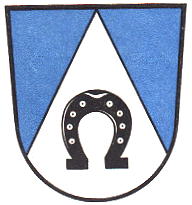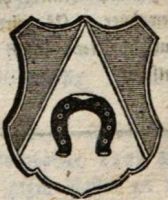Bobingen: Difference between revisions
Jump to navigation
Jump to search
Knorrepoes (talk | contribs) No edit summary |
Knorrepoes (talk | contribs) m (Text replacement - "===Image Gallery===" to "===Image gallery===") |
||
| (3 intermediate revisions by the same user not shown) | |||
| Line 31: | Line 31: | ||
The arms first appear on a seal from the early 19<sup>th</sup> century. The horseshoe is probably the village symbol. In 1768 Clemens Wenezclaus, Bishop of Augsburg summoned all villages to use a specific village sign for border stones etc. Why a horseshoe was chosen is not known. In 1837 the Bavarian colours were added to the horseshoe. | The arms first appear on a seal from the early 19<sup>th</sup> century. The horseshoe is probably the village symbol. In 1768 Clemens Wenezclaus, Bishop of Augsburg summoned all villages to use a specific village sign for border stones etc. Why a horseshoe was chosen is not known. In 1837 the Bavarian colours were added to the horseshoe. | ||
===Image gallery=== | |||
<gallery widths=250px heights=200px perrow=0> | <gallery widths=250px heights=200px perrow=0> | ||
File:Bobingen1841.jpg|alt=Wappen von Bobingen/Arms (crest) of Bobingen|The arms in Kramer (1841) | File:Bobingen1841.jpg|alt=Wappen von Bobingen/Arms (crest) of Bobingen|The arms in Kramer (1841) | ||
| Line 38: | Line 39: | ||
[[Civic Heraldry Literature - Germany|'''Literature''']]: Stadler, 1964-1971, 8 volumes. | [[Civic Heraldry Literature - Germany|'''Literature''']]: Stadler, 1964-1971, 8 volumes. | ||
{{ | {{de}} | ||
{{ | {{media}} | ||
[[Category:German Municipalities B]] | [[Category:German Municipalities B]] | ||
Latest revision as of 08:22, 3 September 2023
|
Country : Germany State : Bayern District (Kreis) : Augsburg (until 1973 Schwabmünchen) Additions:
|
| German | In Blau eine silberne Spitze, darin ein schwarzes Hufeisen. |
| English | blazon wanted |
Origin/meaning
The arms were officially granted on September 29, 1837.
The arms first appear on a seal from the early 19th century. The horseshoe is probably the village symbol. In 1768 Clemens Wenezclaus, Bishop of Augsburg summoned all villages to use a specific village sign for border stones etc. Why a horseshoe was chosen is not known. In 1837 the Bavarian colours were added to the horseshoe.
Image gallery
Postal cancellation (with Aniche)
Literature: Stadler, 1964-1971, 8 volumes.
This page is part of the German heraldry portal |
Heraldry of the World |
|
German heraldry:
|
Selected collector's items from Germany:
|
Contact and Support
Partners:
Your logo here ?
Contact us
© since 1995, Heraldry of the World, Ralf Hartemink 
Index of the site
















